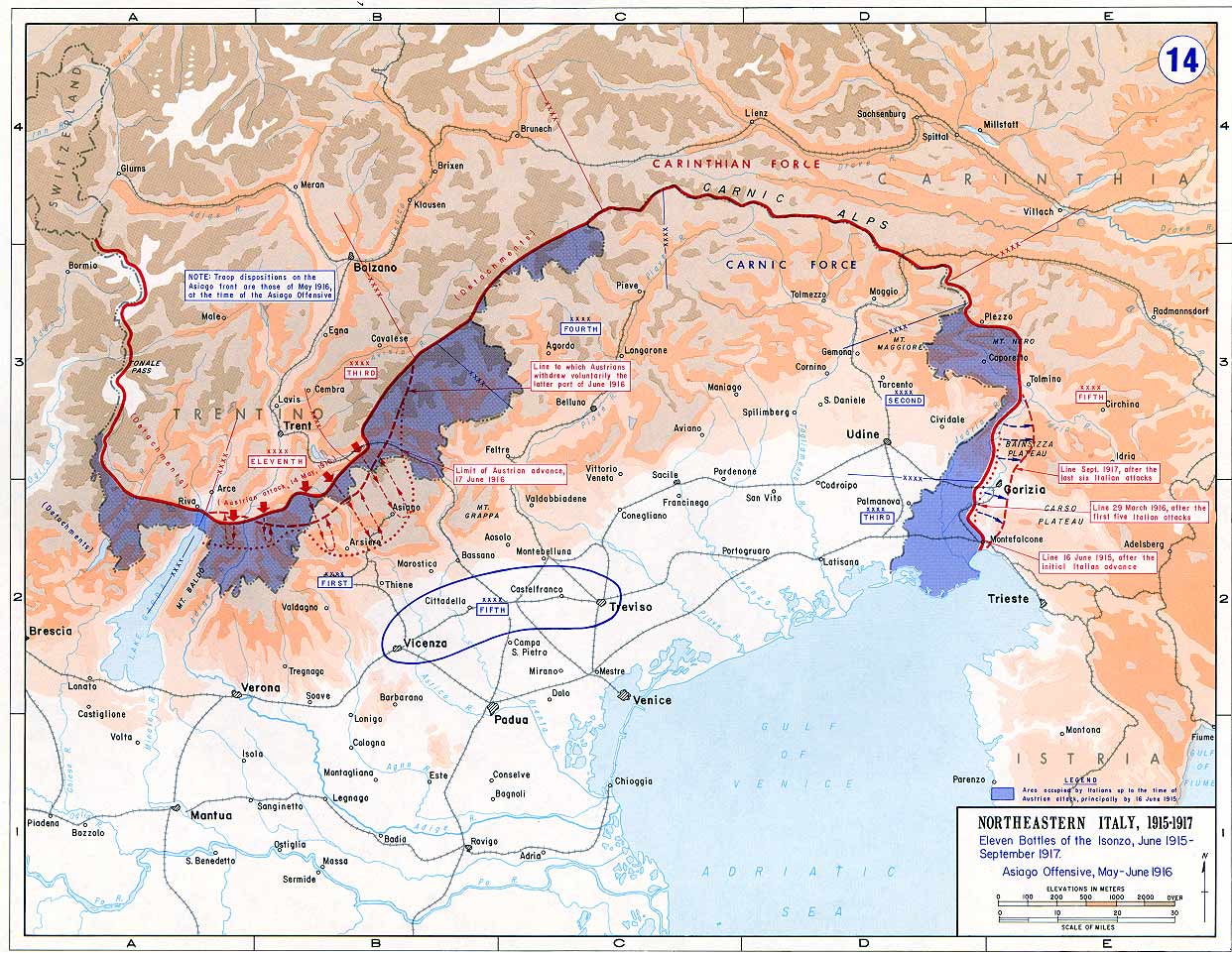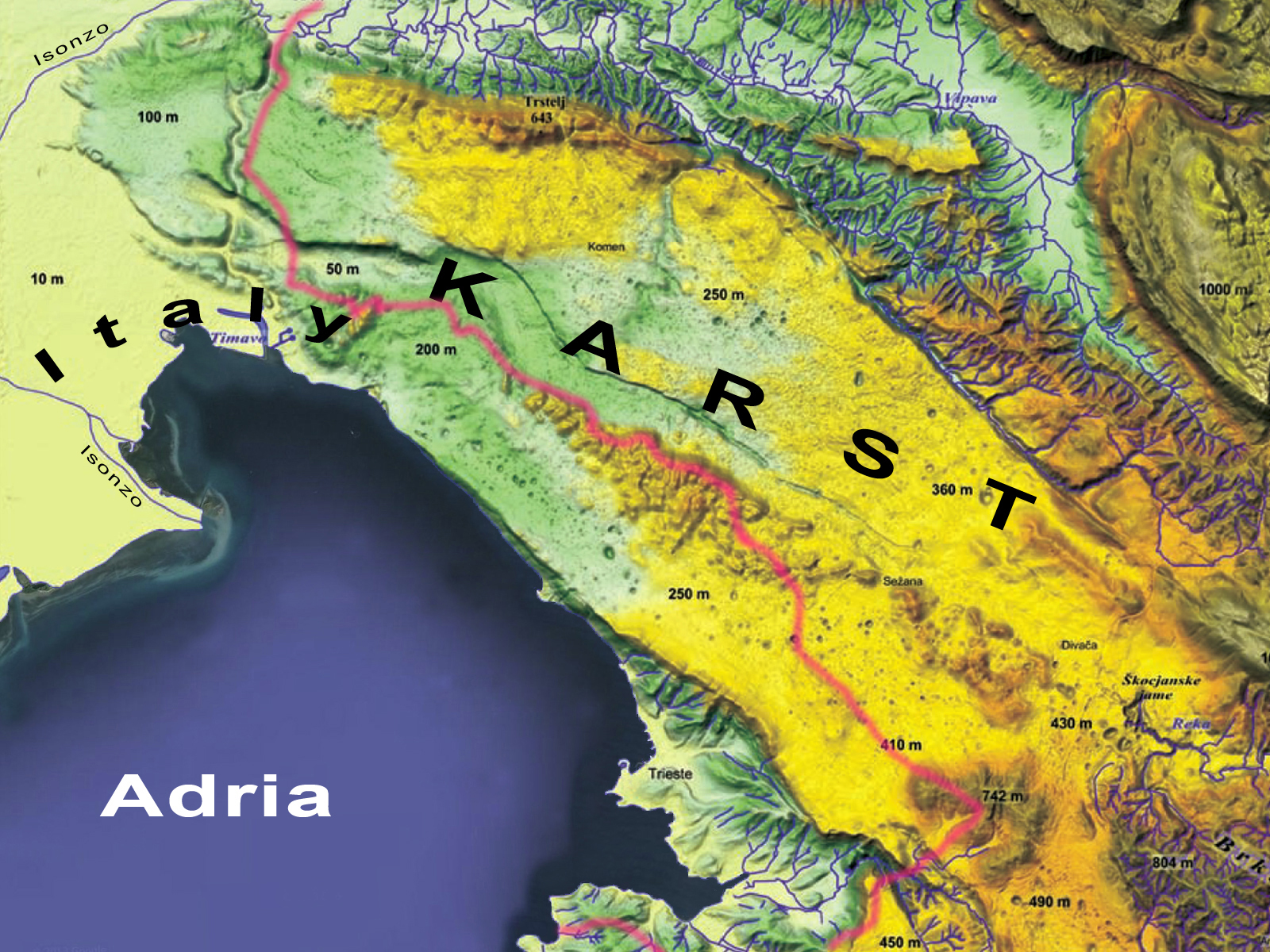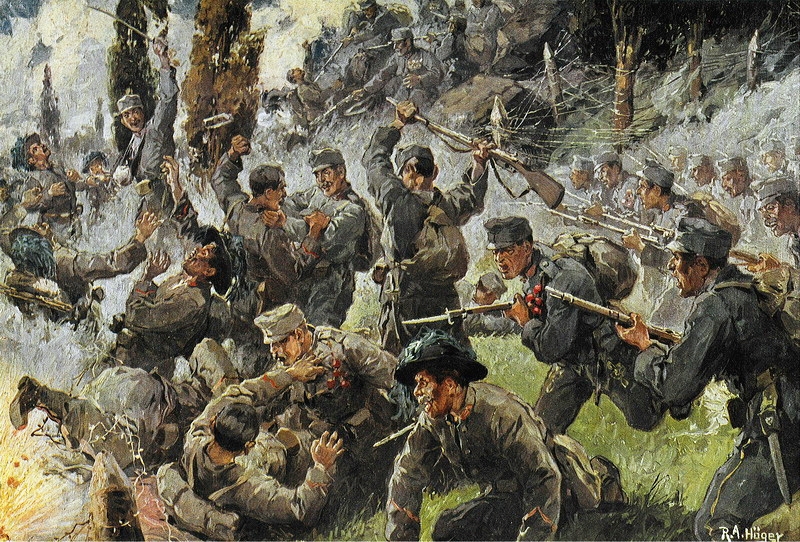Front along Isonzo river
| Site: | MOOC Charles University |
| Course: | Italian front 1915-1917 along the Isonzo river - 2021 |
| Book: | Front along Isonzo river |
| Printed by: | Гість-користувач |
| Date: | Thursday, 23 October 2025, 9:35 PM |
Description
1. Isonzo front
The catchment area of the Isonzo river was the borderline between Italy and Austria-Hungary. The Isonzo front stretched from the north of the Julian Alps and continued south toward the Adriatic Sea. On ths front the eleven Isonzo battles took place, together with the 12th battle which included the German-Austro-Hungarian offensive and the breakthrough of the front at Caporetto. The Isonzo front began in the north in the Tolmin valley. The peak Krn was the precise operational boundary between the Rohr Carinthian group and Boroevic´s Isonzo forces. From Krn, the front line ran through S.Lucia, Avce, Kanal and Plave to Monte Sobotino. From there, an important Austro-Hungarian bridgehead stretched along the western bank of Isonzo, which ended at the south west edge of the town Gorizia. From the town, the line went back down to the river and went up to the Monte San Michel and Doberdo. In the final stretch, the front loped down over San Giovanni al Timavo to Duino and the Adriatic coast.
Italian front 1915-1917

Source:
https://cs.wikipedia.org/wiki/Bitvy_na_So%C4%8Di#/media/File:Italian_Front_1915-1917.jpg
The south wing of the Austro-Hungarian defense was stretched in the area under Gorizia and the karst character of these highlands was very unfavorable, with labyrinthine, impassable and uncovered terrain, and the difficulty of building shelters and engineering work. The flat and slightly waved area on the opposite west bank of the Isonzo river provided the Italian army many advantages, especially the easy deployment of numerous infantry and artillery, and a fast maneuvering and undisturbed flow of reserves from the Italian hinterland. Therefore, the Italians could launch mass attacks with tremendous artillery support, comparable to the trench warfare on the western front. Both sides knew how strategically important the Isonzo river basin was because if the Italians succeeded in breaking the front, this would mean a disaster for the entire Austro-Hungarian front.
The Italian army could move quickly into inland of the empire (up to Ljubljana) and to the Dalmatian coast. This would have decided about the war. The Italian General Staff, led by Lieutenant-General Luigi Cadorna, tried to make a breakthrough on the Isonzo front. Here was the core of the Italian field armies, and Austro-Hungarian General Staff had to gradually withdraw all the forces that could be released from the eastern front, the Balkans, or the mountain sections of the Italian front.
Source:
ČEPELKA, M.: Fronta v Dolomitech 1915-1917, Lysá nad Labem 1997.
2. Natural conditions
The natural conditions and stony terrain of the Kras1 made it difficult to fight there. And so the Austro-Hungarian soldiers were brought at the beginning of the fighting into completely unfamiliar territory. Field blades were worthless for digging in hard limestone. Terrain hollows made by water erosion, called doline, were often the only shelters from observation and the firing of the enemy. The limestone fragments, shredded by artillery shells, multiplied the effect of this fire and caused severe injuries. For this reason, the Austro-Hungarian defenders set up a protective shield by heaping dead soldiers on their shallow trenches. The trenches were dug through hammers and chisels in intervals between battles. It was a great achievement when a soldier managed to deepen the bottom of the trench by 5 centimeters in one night.
The exhaustion of soldiers was also caused by a lack of water, despite the leaking through the limestone subsoil. Thirst became the insurmountable companion of the Isonzo soldier. Basic needs had to be transported to the front during the night by carriers or pack animals, but ammunition and medical supplies took priority. Although Austro-Hungarian General Staff considered helmets as a luxury in the beginning, it was forced to requisition them quickly because of the fatal head injuries from the flying limestone pieces. At the beginning, ineffective dragoon and fire brigade helmets were used, or Italian helmets (which were officially banned) and later in the first year steel helmets.
Karst Plateau

Source:
The battle quickly turned into trench warfare, in which the dense artillery fire of the Austro-Hungarian troops did not give the enemy much chance to approach. As a result, the Italian High Command proceeded with massive artillery attacks that destroyed everything around the edge of the defense, so the battle was prolonged. At the same time, with the increased participation of heavy strength and naval artillery, the destruction increased. After such devastating fire, they set out into a silent area covered with pieces of steel, craters, scree and masses of fallen soldiers. The attackers who managed to penetrate the Austro-Hungarian trenches were stabbed in hand to hand battle, as there was no time to take prisoners. Of the regiments made up of three to four thousand men, after a few days of battle only small groups of fifty to sixty men remained. They then retreated to the queue of waiting reinforcements from the arriving trains and again sent to bloody cuttings.
1 Kras is the name of the karst area extending across the border of southwestern Slovenia and northwestern Italy.
Source:
ČEPELKA, M.: Fronta v Dolomitech 1915-1917, Lysá nad Labem 1997.
2.1. Video
Isonzo front
Time:
6:19 - 7:13
3. Battles on Isonzo front
The Austro-Hungarian High Command tried to find a solution of the permanently increasing Italian numerical strength and resources. That is why they was inspired by the German example in the spring of 1916 and decided to use the poisonous gas. The Italian side responded with a gas retaliation. More and more resistant defense on both sides required the implementation of special assault troops, and also the Air Force took part during the 4th Isonzo battle. All this has increased the destruction of the fighting which culminated in the 10th and 11th Isonzo battle.
During the first four battles, the main line of the Isonzo front was settled. The most violent fighting took place at Plava, then on the Gorizia bridgehead at Monte Sabotino, on Podgora and in karst on Monte San Michele and Monte dei Sei Busi. The Italian side has achieved only minor territorial gains. Gorizia was almost razed to the ground during the fighting of 10-13 December 1915. Italian rival managed to penetrate the the heights of Doberdo in the 5th battle and got into the middle of the first Austro-Hungarian defense position, even though Italians were thrown back during counter-attacks.
The 6th battle meant Italian tactical success. The Italians succeeded in conquest of Gorizia and strategically important Monte San Michele. In the following three battles, the main Italian onslaught concentrated on the south wing of the Isonzo front. The aim of Cadorna's strategy was to reach Trieste together with the port, which, after pushing the Austro-Hungarian troops to the second defensive position, seemed to be within reach. That is why, in the 10th and 11th Isonzo battle, the Italian Command was trying to finally break the front with the deployment and the exertion of all its forces.
Source:
FUČÍK, J.: Soča (Isonzo) 1917, Prague-Litomyšl 1999.
ŠEDIVÝ, I.: Češi, české země a Velká válka 1914-1918, PraGUE 2001.
Battles on Isonzo front - "Kämpfe auf dem Dobredo", Rudolf Alfred Höger

Source:
https://en.wikipedia.org/wiki/Battles_of_the_Isonzo#/media/File:K%C3%A4mpfe_auf_dem_Doberdo.JPG